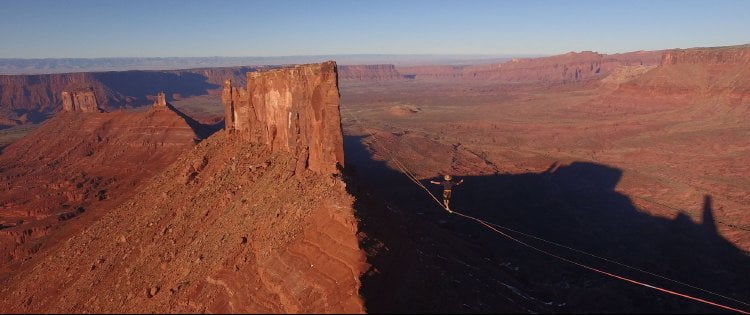Mountain

300 years ago, if you told people that you were going to climb a mountain, you would be considered certifiably insane. Now, thousands, even tens of thousands of people trek every year to climb (and more) some arduous and often deadly “Mountain.”
Laura's Review: B-
There have been so many documentaries about Mountains and the extreme sports which surround them in recent years - "Touching the Void," "Meru," "Sunshine Superman," etc., so what makes "Mountain" different? Cowriter (with Robert Macfarlane)/director Jennifer Peedom ("Sherpa") takes a poetic approach to the subject, narrator Willem Dafoe pondering why, after centuries of being considered 'the realm of the holy and the hostile,' people became obsessed with conquering mountains. Beginning with black and white footage of the Australia Chamber Orchestra warming up and Dafoe in a recording booth, we're quickly plunged into various shots of mountains around the world, zooms identifying the tiny figures intent on scaling them (or skiing down them, or parasailing from them, or mountain biking atop them or tightrope walking between them). Drones and GoPros capture incredible imagery, many vertigo inducing. In one amazing bit of footage, a woman leans out of a tent perched on the side of a snow covered mountain to look at the clouds undulating like a quilt being fluffed far below. The film is beautifully edited, scenes paired with Dafoe's words as well as the score. The film's final shot, a zoom out, is an amusing replication of the Paramount logo. With the exception of Everest, locations are not identified until the closing credits. "Mountain" is all very pretty and awe-inspiring while watching it (although much of the footage is overly familiar), but I had trouble recalling what movie I'd watched two days later. As a documentary, it doesn't offer much we haven't seen before, but it would have made an incredible release for IMAX. Grade:
Robin's Review: B
Willem Dafoe narrates this unique look at nature’s majestic mountains that, as you watch the travelogue unfold, you notice the film does not identify the many peaks shown and the people that try to master them. Some may deride that we only told the what, not the where and who. What the credits for that info Let me count (only some) of the ways people recreate in a world both “holy and hostile.” The usual one is climbing (think Everest). Other mountainous high jinks include rappelling down a sheer cliff thousands of feet high; climbing up said sheer cliffs thousands of feet high with just your hands and feet (no ropes, no pitons); skiing down from a mountain peak; tight rope walk between two peaks; motor cross through a mountain range; BMX down the side of a mountain; parasail skiing; fly through the mountains in a flying squirrel suit; jump out of a helicopter and ski down from the top of an otherwise inaccessible slope. And, there are more imaginative adrenalin-fueled acts by crazy people The filmmakers give a short history of the “sport” of mountain climbing, starting with the historic conquest of Mount Everest, the world’s highest peak, in 1953 by Sir Edmund Hilary and his faithful Sherpa guide Tenzing Norgay (who most probably was the first at the peak but, you know, he’s a Sherpa, so the white guy gets the credit). Since that time, the abovementioned sports have expanded by a magnitude, if not more. But, the filmmakers also show how tourism has played such a critical role in mountain management and, often, exploit that precious resource. The point, one point at least, of “Mountain” is to show the vast and varied majesty of this once unexplored world. How the filmmakers are able to get such astounding panoramic views of so many peaks is a story unto itself. Did they use drone cameras and/or helicopter camera platforms? They did use footage of those daring adrenalin junkies who wear body cams during their truly death defying feats. This is for those junkies and for us couch potatoes, too.

